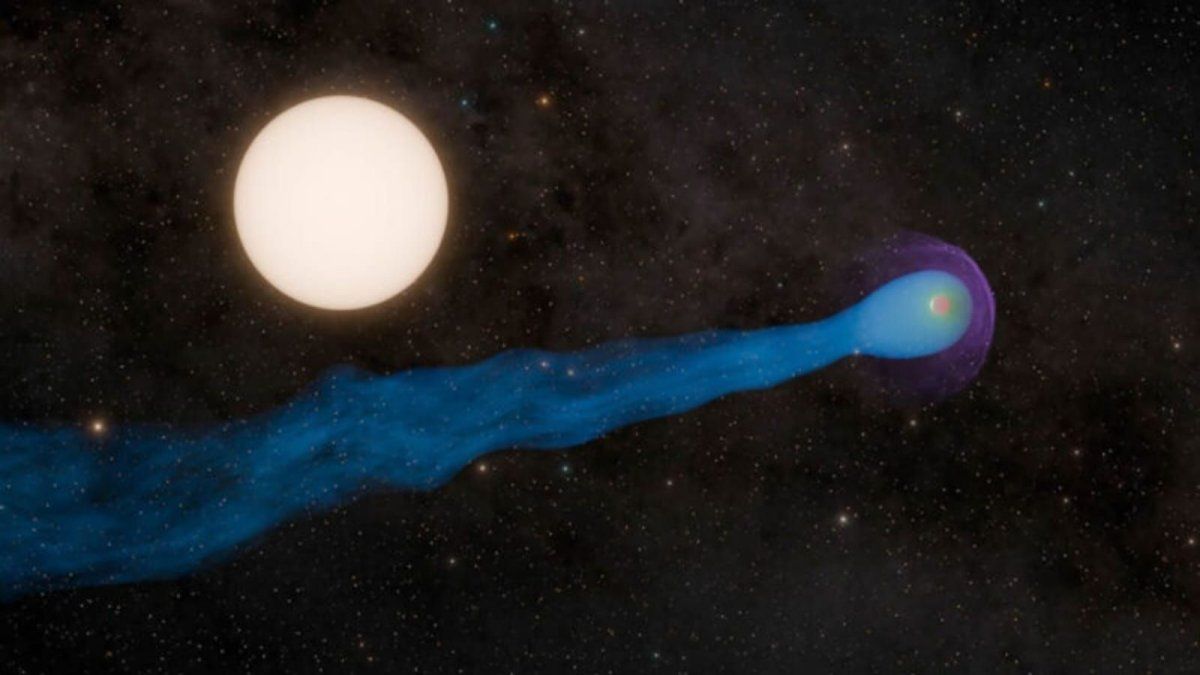In a discovery that redefines the understanding of certain astronomical phenomena, a team from the POT discovered that the exoplanet WASP-69b leaves a trail of gas in its path. This unusual feature was detected through detailed observations made with the Keck II telescope, using the NIRSPEC spectrograph.
A team of scientists led by Dakotah Tyler, University of California, Los Angelesdiscovered that the exoplanet WASP-69b is not only a giant gaseous sphere similar to Jupiter, but a celestial body that leaves a trail of gas in its path, resembling a comet.
The new “planet with a tail” discovered by NASA
The discovery raises a new perspective on how planetary atmospheres can interact with the stellar environment. While some exoplanets lose gases uniformly, WASP-69b projects a hydrogen-helium tail that extends more than 563,269 km. (at least 7.5 times the radius of the planet), a phenomenon driven by the intense stellar winds of its host star.
According to Tyler, this behavior is comparable to what happens with a windsock that inflates when it receives a current of air. “If the stellar winds intensify, the gas escapes from the planet and is molded into a tail,” explained the principal researcher. This makes WASP-69b a natural laboratory to understand how exoplanets lose mass and how these losses are shaped by their cosmic environment.
wasp69b
These discoveries make WASP-69b a natural laboratory for understanding how exoplanets lose mass.
@DaneyCasey
What is WASP-69b like?
WASP-69b, a “hot Jupiter,” is a gas giant orbiting at a short distance from its star, a K-type dwarf. Due to this proximity, intense stellar radiation heats its outer layers, causing a phenomenon called photoevaporation, in which light gases such as hydrogen and helium are launched into space.
However, instead of escaping in all directionsstellar winds from the host star redirect this flow of gas, sculpting a long comet-like tail. This dynamic interaction reveals how extreme stellar environments can alter planetary evolution.
The shape and length of WASP-69b’s tail are not fixed. The stellar wind acts as a cosmic sculptor, varying the tail depending on its intensity and the activity of the star. The researchers believe that this variable interaction could also help study stellar activity in other stars.
Planetary tails could act as “stellar wind indicators,” providing clues to stellar phenomena that would otherwise be difficult to observe.. This discovery is detailed in the scientific article published in The Astrophysical Journal, titled “WASP-69b’s exhaust envelope is confined to a tail extending at least 7 Rp,” with observations made in 2019 and analysis updated until 2024.
Earth received a message sent by laser 16 million kilometers away
The transmission of information is one of the most important things for space exploration. It is usually carried out through devices such as probes and satellites, among others.. It all depends on the reception and the way of collecting data so that it can later be studied in detail.
For this reason, for decades we worked on research into how to transmit this information and receive it efficiently, taking into account the distances and movements that make the issue more complex. However, NASA continues with research and projects that aim to improve the technologies that allow space exploration, since they consider it a key aspect to understand the universe as much as possible.
Source: Ambito
I am Pierce Boyd, a driven and ambitious professional working in the news industry. I have been writing for 24 Hours Worlds for over five years, specializing in sports section coverage. During my tenure at the publication, I have built an impressive portfolio of articles that has earned me a reputation as an experienced journalist and content creator.




